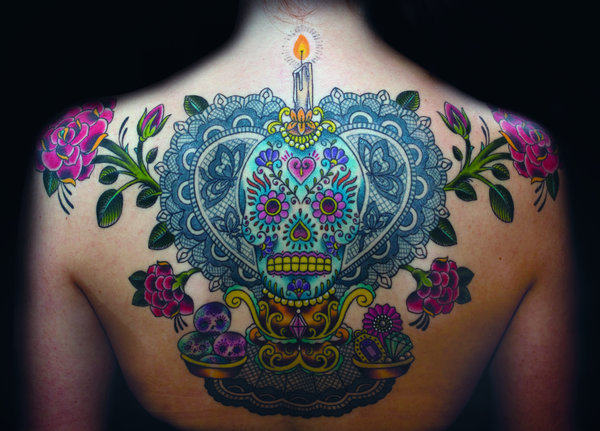SlingerVille Articles
 Our Bodies, Our Ink
Our Bodies, Our Ink
Article by: NY Times
July 05, 2013
Among the first mainstream American celebrities to openly wear tattoos was Janis Joplin. On her left wrist, she had a Florentine bracelet. On her chest, she wore a small heart — the size of a candy heart. “Just a little treat for the boys,” she told Rolling Stone, “like icing on the cake.”
It seems like only yesterday that tattoos were rarities, like certain crows. They were worth commenting upon, either for their beauty or their banality. Now tattoos creep like vines along the arms, legs and torsos of nearly everyone you meet. If print is dead, ink is undead — and on the move.
There’s been some sophisticated fiction about skin and ink. I’m thinking especially of Sarah Hall’s novel “Electric Michelangelo,” a finalist for the 2004 Man Booker Prize. But it’s a lacunae in our literature that there hasn’t been a definitive nonfiction book on the topic, a volume that packs sociology and criticism and history and memoir into a dense sleeve, as a tattoo artist might put it, of meaning.
While we await that book, we have Margot Mifflin’s perceptive and moving “Bodies of Subversion: A Secret History of Women and Tattoo,” first published in 1997 but reissued now in a heavily updated and resplendently illustrated third edition.
For most of history, tattooing has been a male preoccupation, either a one-fingered salute or an exercise in swagger. Think of Popeye and his twin anchors. Ms. Mifflin had the good idea to examine tattooing in the Western world from a female perspective. Her relatively slim book doesn’t provide a truly wide-angle view, but the insights she brings are insinuating and complex.
This new edition of “Bodies of Subversion” arrives at the crest of a wave. For the first time, according to a 2012 Harris Poll, American women are more likely to be tattooed than men. Some 23 percent of women have tattoos; 19 percent of men do. They’re no longer rebel emblems, Ms. Mifflin notes. They’re a mainstream fashion choice.
She is mostly an admirer of women’s tattoo culture. Tattoos have been “emblems of empowerment in an era of feminist gains,” she declares. They’re also “badges of self-determination at a time when controversies about abortion rights, date rape and sexual harassment” have made women “think hard about who controls their bodies.”
Her book includes striking color photographs of the tattoos some women have had embroidered on their chests after mastectomies. Thanks to recent legislation, tattoo artists can sometimes directly bill insurance companies for this work.
(If only Joplin had known that it would be possible to have your weed and your tattoos covered by insurance, she might have decided to stick around.)
But Ms. Mifflin is a flinty observer. She notes that tattoos have the “ability to degrade as well as to enhance, to invoke the sacred and the inane.” She assesses the work of social critics who posit that tattooing can be a political cop-out, a cover for disengagement.
These critics argue, she writes, that “tattooing shifts the focus of women’s issues from society to the self; that tattooed women are empowered only in their minds; and that women who find solace in tattoos are no different from women for whom shopping and exercise are substitutes for problem-solving.” Ouch, as the client said to the tattooist.
“Bodies of Subversion” is delicious social history. Tattooing was an upper-class social fad in Europe in the late 19th century. Winston Churchill’s mother had a tattoo of a snake eating its tail (the symbol of eternity) on her wrist. The fad spread to America. In 1897, Ms. Mifflin writes, The New York World estimated that 75 percent of American society women were tattooed, usually in places easily covered by clothing.
By the 1920s, tattooed women were mostly to be seen in freak shows and in circus acts, where they could make more money than tattooed men. They offered, the author avers, “a peep show within a freak show.”
Tattoos lost their appeal for nearly everyone shortly after World War II. One reason was because “tattoos perpetrated in concentration camps had added a ghastly new chapter to tattoo history.”
Ms. Mifflin’s story spins forward through the tattoo revival of the 1970s, when women with a tattoo or two began to shake the stigma that they were sexually available. She moves attentively through the 1980s and ’90s, the era that gave us Dennis Rodman, the lower-back tattoos now known as tramp stamps and a kudzu forest of copycat tribal tats.
Her final chapter takes us up to the present day, with assessments of the tattoo artist Kat Von D’s fame and of cultural moments like the popularity of Stieg Larsson’s 2005 novel “The Girl With the Dragon Tattoo.” Ms. Mifflin appraises the work of famous female tattoists; she argues that the world needs tattoo critics. I hereby nominate Tim Gunn and Lil Wayne as the genre’s Siskel and Ebert.
She is at her best when considering class and tattoos. She quotes an inked-up female doctor who says that it’s easier for professional women to wear them at work: “If you’re working some crummy little desk job with a dress code, it’s a lot harder to walk around wearing your tattoos in the open.”
Ms. Mifflin deals, too, with the matter of tattoo regret. There’s plenty of that going around. She cites a survey by the Archives of Dermatology stating that 69 percent of tattoo removal requests come from women. Most got stamped at the age of 20 or so. Quoting the same survey, she says about tattoos, “Their marks of uniqueness ‘turned into stigmata.’ ” But the Harris Poll cited above also noted that 86 percent of tattooed people were content with their ink.
Those who would shame women with tattoos often utter things like: How are those things going to look when you’re old and wrinkled? On the basis of the photographs of older women with tattoos in this book, I’d say they hold up pretty well.
In fact, I’d say they look sort of awesome.
Source: http://www.nytimes.com/2013/07/04/books/bodies-of-subversion-explores-womens-tattoos.html?_r=0
Login to comment
Comments
Posted By: LeftLaneLarry |
7/05/13 4:19 PM
I always knew Janis was a trend setter. It really is a shame she was taken away from us so early in her life.
Login to reply
Posted By: sarcastikchik |
7/10/13 3:30 PM
I LOVE JANIS JOPLIN!!! Glad she paved the way for woman like me. I am a professional person, have to wear suits to work, but I am tatted like on my arms, legs, back and chest. I don't mind wearing long sleeve jackets, cause when I take my jacket off outside of work hours in my office, and co-workers see my tatts, they give me funny looks. Oh well, tatted, smart and what??? lol

